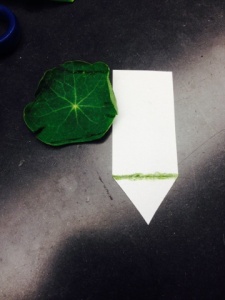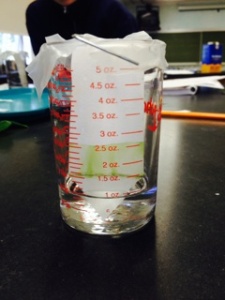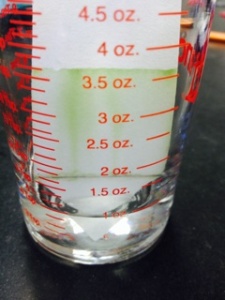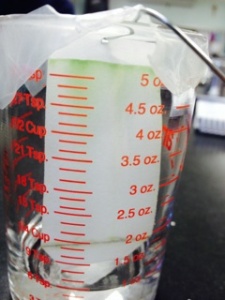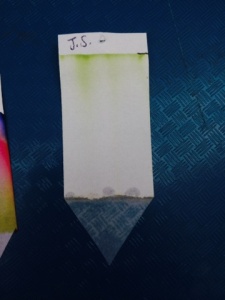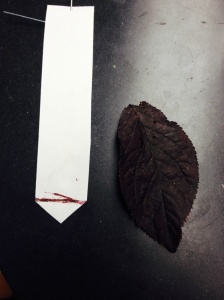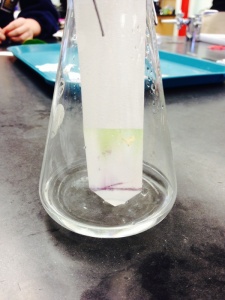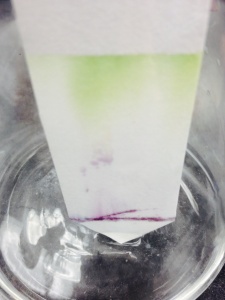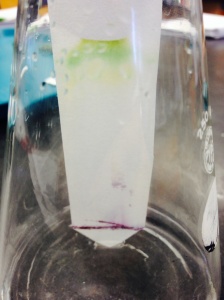Have you ever wondered about the composition of colors? If so, try chromatography! Meaning “to write with colors” in Greek, this is a scientific tool used very frequently. First developed in the 1900s, chromatography was used to separate the pigments in plants. Although my AP Bio class did the same lab of using chromatography to separate plant pigments, many other gases and liquids can be separated with this. There are many different forms of chromatography: gas, paper, light, column, and a few others. The most commonly used form is paper chromatography, which is the experiment I did. The purpose of chromatography is to separate the different components of a substance. Every paper chromatography experiment starts off with a stationary phase. This phase starts off which a solid substance that does not move. Once the solvent starts to move up the paper due to adhesion, or the attraction of one substance to another, so does the solid. The moving phase is called the mobile stage. The different parts of the solid begin up the paper with the solvent and some move at different speeds and stop at different heights.
 https://c2.staticflickr.com/6/5095/5522044271_7938f15da2_b.jpg
https://c2.staticflickr.com/6/5095/5522044271_7938f15da2_b.jpg
Why does this happen? There are some deciding factors of movement. The first factor is the solubility of the solute, or how much the substance likes the solvent. If the component is very soluble and likes the solvent, then the substance will continue to move up the paper. If the component of the substance is not very soluble, then the component will move a minimal distance and become sedentary. Another deciding factor is the mass of the solid. If the substance is very light, then the distance traveled will be greater. If the substance is not light, then more power will be required to move the substance. The third factor is how much the substance is attracted to the paper. The substance will be less likely to move if more attracted to the paper. Whereas, if the substance is more attracted to the solvent than the paper, the substance will continue to travel up the paper. As you can tell, the paper and the solvent are two necessary parts of this experiment. Without the solvent, the substance would not separate. Without the paper, the separation of the substance would not be seen. The solvent would have nothing to travel on, and the substance would not be able to be noticeably separated. Since the substance components move at different distances, each spot on the chromatography has an individual Relative Mobility Factor. This is a ratio of the distance a substance travels to the distance the solvent travels. By having individual Rf’s, scientists can compare the different substances and determine what they are. Every substance has a constant Rf that is the same for every experiment with a consistent set of chromatography conditions. Scientists can run the experiment, find the Rf using the Dunknown, and determine what it is. The Dunknown is the distance traveled of the unknown substance. This is divided by the distance of the solvent to determine the Rf.
 http://upload.wikimedia.org/wikipedia/commons/d/d2/Chromatography_tank.png
http://upload.wikimedia.org/wikipedia/commons/d/d2/Chromatography_tank.png
Before we started the experiment, we ran a “control” with a felt tip pen and water seen below. We each did the experiment with different size and shape containers. One was a small cylinder, which had a short and thick piece of paper. The data resulted was the most precise. Another container was an erlenmeyer flask which had a thin, long paper strip. The solvent traveled the fastest up the strip. The last container was a beaker, which had a long and thick paper. The data was an average of both.
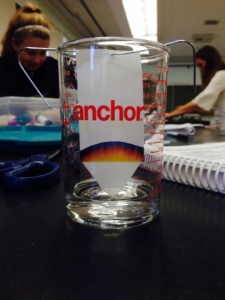
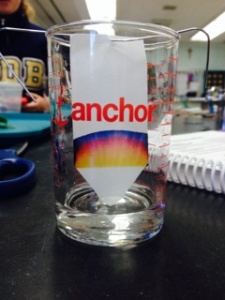
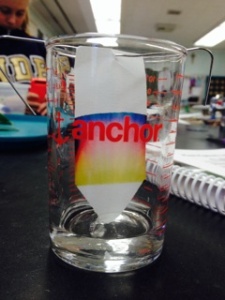
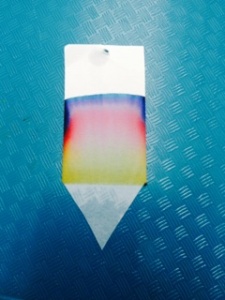
Then we ran the actual experiment. Using the same three containers with the same sizes of paper, this time we used plant leaves instead of marker. We used one purple leaf and two different green plant leaves. First we cut a triangle at the bottom of the chromatography paper. Then we drew a light line across the top of the triangle. Next we placed the leaf on top of this light line and pressed the pigment into the paper. I used a green leaf for this experiment as seen in the pictures below. Once it was dark enough, we hung the strip on a paper clip and lowered the paper into the acetone. After covering the container with wax paper so the acetone does not evaporate, we watched as the pigment moved up the paper. In the green leaf, there was a lot of green, some light green, and some yellow.
In the purple leaf, there was orange, yellow, green, light green, and purple see below. It was amazing to see all the different pigments a leaf contains! One would think that a green leaf only has green pigments, but we found out that the leaf has yellow too! The color of something depends on what wavelengths of light that object absorbs. If you see something colored purple, this means that object absorbs all the other colors of the spectrum besides purple. Objects reflects the color not absorbed which is why purple is what we see.
These different pigments have different functions for the leaves. Although pigments all absorb light energy, different pigments absorb different wavelengths of light. This is why there are so many different pigments found in each leaf! Chlorophyll may be the main pigment of photosynthesis, but all the other pigments such as Carotene, Xanthophyll, are all important. Photosynthesis would not take place without the pigments, because light energy is a necessity. The plant cells get the energy to break down carbon dioxide into oxygen and sugar, from the light.
Question Section
1. How do computer engineers make it so that we can make our paper absorb all but purple or absorb all but blue? How do they design the program so that we can change the color of letters in word, and sticky notes?
2. If the color we see is the light reflected, then does our skin absorb all the colors of the spectrum? Why is skin pigmented a range of white to brown? Why aren’t colors reflected in our skin?
If you have any additional questions, reply in the comment section below!
Sources
Marsella, Gale. “What Is Chromatography? – Definition, Types & Uses.” Education Portal. N.p., n.d. Web. 6 Nov. 2014. <http://education-portal.com/academy/lesson/what-is-chromatography-definition-types-uses.html#lesson>.
“History of Chromatography.” History of Chromatography. University of Michigan, n.d. Web. 06 Nov. 2014. <http://www.umich.edu/~orgolab/Chroma/chromahis.html>.

